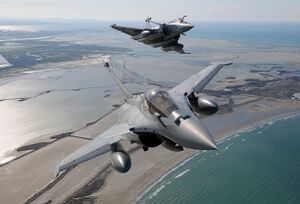Zephyr: Difference between revisions
No edit summary |
No edit summary |
||
| Line 28: | Line 28: | ||
The '''Zephyr''' is a [[Syara]]n version of the [[T-35 Séideán]] {{wp|multirole fighter}} first introduced by [[Ossoria]] in 1994. The Zephyr performs various roles, including air-to-air combat, ground support, anti-ship strike, and interdiction. It differs from the T-35 in usage of Syaran avionics and armarments, although the majority of the Zephyr's components remain the same. | The '''Zephyr''' is a [[Syara]]n version of the [[T-35 Séideán]] {{wp|multirole fighter}} first introduced by [[Ossoria]] in 1994. The Zephyr performs various roles, including air-to-air combat, ground support, anti-ship strike, and interdiction. It differs from the T-35 in usage of Syaran avionics and armarments, although the majority of the Zephyr's components remain the same. | ||
The T-35 was selected over competition from the [[Cacerta|Cacertian]] [[AFASF-12 Drago Air Superiority Fighter]] and the [[Acrea]]n [[Aestrup EF | The T-35 was selected over competition from the [[Cacerta|Cacertian]] [[AFASF-12 Drago Air Superiority Fighter]] and the [[Acrea]]n [[Aestrup EF 165 Draken|EF-165 Draken]] owing to the T-35's superior air-to-ground and anti-ship strike capabilities, which were considered essential given Syara's strategic situation. The first purchase of T-35s were achieved in 1995, with production rights later acquired in 1999. The T-35 was redesignated as the ''Zephyr'' by the [[Commonality Air Force]] and was intended to serve as a more capable platform than the domestically designed [[Ceyx]], which shared many similarities in design. | ||
The Zephyr first saw combat during the [[Imerti Conflict]] where it engaged in air-to-air combat against the [[Ruvelkan Imperial Air Force]] and provided air support for [[Syaran National Army|Syaran ground forces]]. Production of the Zephyr increased afterwards and became Syara's primary front line fighter during the [[Zemplen War]]. Production however fell short of demand, leaving the CAF at a numerical disadvantage against the Ruvelkan air force. Zephyrs performed a number of roles throughout the conflict, shooting down 267 aircraft of all types for 49 combat losses, with an additional 13 lost due to accidents. [[Flying Aces of the Zemplen War|Five Syaran pilots]] became aces flying the Zephyr, and post-war analysis by the CAF concluded that the Zephyr was the best multi-role fighter of the conflict. Information gathered during the war was later shared with Ossoria to produce the next generation of T-35 and Zephyr fighters. | The Zephyr first saw combat during the [[Imerti Conflict]] where it engaged in air-to-air combat against the [[Ruvelkan Imperial Air Force]] and provided air support for [[Syaran National Army|Syaran ground forces]]. Production of the Zephyr increased afterwards and became Syara's primary front line fighter during the [[Zemplen War]]. Production however fell short of demand, leaving the CAF at a numerical disadvantage against the Ruvelkan air force. Zephyrs performed a number of roles throughout the conflict, shooting down 267 aircraft of all types for 49 combat losses, with an additional 13 lost due to accidents. [[Flying Aces of the Zemplen War|Five Syaran pilots]] became aces flying the Zephyr, and post-war analysis by the CAF concluded that the Zephyr was the best multi-role fighter of the conflict. Information gathered during the war was later shared with Ossoria to produce the next generation of T-35 and Zephyr fighters. | ||
Revision as of 00:15, 27 October 2021
| Zephyr | |
|---|---|

| |
| Role | Multirole fighter |
| National origin | |
| Introduction | 1995 |
| Status | In service |
| Primary user | Commonality Air Force |
| Produced | 1999-Present |
| Number built | 1,000+ |
| Developed from | T-35 Séideán |
The Zephyr is a Syaran version of the T-35 Séideán multirole fighter first introduced by Ossoria in 1994. The Zephyr performs various roles, including air-to-air combat, ground support, anti-ship strike, and interdiction. It differs from the T-35 in usage of Syaran avionics and armarments, although the majority of the Zephyr's components remain the same.
The T-35 was selected over competition from the Cacertian AFASF-12 Drago Air Superiority Fighter and the Acrean EF-165 Draken owing to the T-35's superior air-to-ground and anti-ship strike capabilities, which were considered essential given Syara's strategic situation. The first purchase of T-35s were achieved in 1995, with production rights later acquired in 1999. The T-35 was redesignated as the Zephyr by the Commonality Air Force and was intended to serve as a more capable platform than the domestically designed Ceyx, which shared many similarities in design.
The Zephyr first saw combat during the Imerti Conflict where it engaged in air-to-air combat against the Ruvelkan Imperial Air Force and provided air support for Syaran ground forces. Production of the Zephyr increased afterwards and became Syara's primary front line fighter during the Zemplen War. Production however fell short of demand, leaving the CAF at a numerical disadvantage against the Ruvelkan air force. Zephyrs performed a number of roles throughout the conflict, shooting down 267 aircraft of all types for 49 combat losses, with an additional 13 lost due to accidents. Five Syaran pilots became aces flying the Zephyr, and post-war analysis by the CAF concluded that the Zephyr was the best multi-role fighter of the conflict. Information gathered during the war was later shared with Ossoria to produce the next generation of T-35 and Zephyr fighters.
The Zephyr is slated to serve until the 2040s and remains the principle mainline fighter of the Commonality Air Force, and total production is expected to exceed 1,000 airframes.